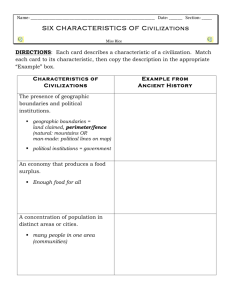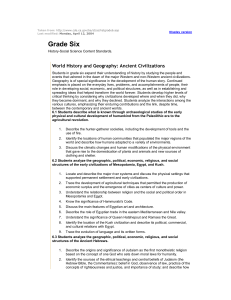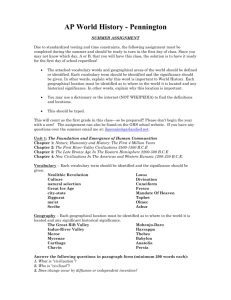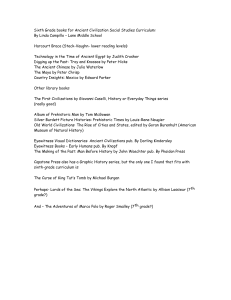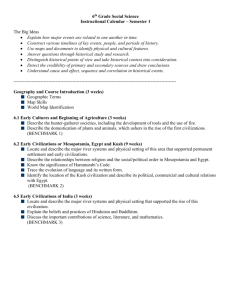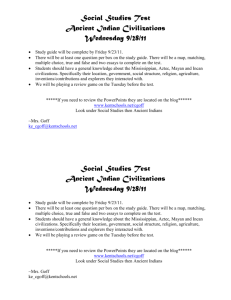grade 6 - Oakland Unified School District
advertisement
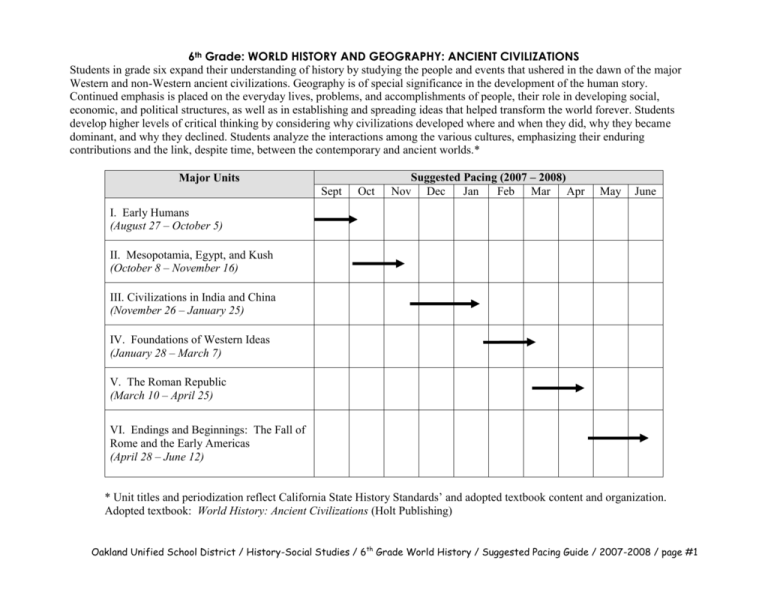
6th Grade: WORLD HISTORY AND GEOGRAPHY: ANCIENT CIVILIZATIONS Students in grade six expand their understanding of history by studying the people and events that ushered in the dawn of the major Western and non-Western ancient civilizations. Geography is of special significance in the development of the human story. Continued emphasis is placed on the everyday lives, problems, and accomplishments of people, their role in developing social, economic, and political structures, as well as in establishing and spreading ideas that helped transform the world forever. Students develop higher levels of critical thinking by considering why civilizations developed where and when they did, why they became dominant, and why they declined. Students analyze the interactions among the various cultures, emphasizing their enduring contributions and the link, despite time, between the contemporary and ancient worlds.* Major Units Sept Oct Suggested Pacing (2007 – 2008) Nov Dec Jan Feb Mar Apr May June I. Early Humans (August 27 – October 5) II. Mesopotamia, Egypt, and Kush (October 8 – November 16) III. Civilizations in India and China (November 26 – January 25) IV. Foundations of Western Ideas (January 28 – March 7) V. The Roman Republic (March 10 – April 25) VI. Endings and Beginnings: The Fall of Rome and the Early Americas (April 28 – June 12) * Unit titles and periodization reflect California State History Standards’ and adopted textbook content and organization. Adopted textbook: World History: Ancient Civilizations (Holt Publishing) Oakland Unified School District / History-Social Studies / 6th Grade World History / Suggested Pacing Guide / 2007-2008 / page #1 6th Grade World History California State Content Clusters and “A” Standards Suggested Pacing 2007 – 2008 I. Early Humans and Societies Suggested Time Frame: August 27 – October 5 6.1 Students describe what is known through archaeological studies of the early physical and cultural development of humankind from the Paleolithic era to the agricultural revolution. “A” Standard(s): (6.1.2) Identify the locations of human communities that populated the major regions of the world and describe how humans adapted to a variety of environments II. Mesopotamia, Egypt, and Kush Suggested Time Frame: October 8 – November 16 6.2 Students analyze the geographic, political, economic, religious, and social structures of the early civilizations of Mesopotamia, Egypt, and Kush. “A” standard(s): (6.2.1) Locate and describe the major river systems and discuss the physical settings that supported permanent settlement and early civilizations. (6.2.3) Understand the relationship between religion and the social and political order in Mesopotamia and Egypt. (6.2.5) Discuss the main features of Egyptian art and architecture. Relevant Textbook Chapters 1, 2 Relevant Textbook Chapters 3, 4, 5 Oakland Unified School District / History-Social Studies / 6th Grade World History / Suggested Pacing Guide / 2007-2008 / page #2 III. Civilizations of India and China Suggested Time Frame: November 26 – January 25 Relevant Textbook Chapters 6.5 Students analyze the geographic, political, economic, religious, and social structures of the early civilizations of India. “A” Standard(s): (6.5.5) Know the life and moral teachings of Buddha and how Buddhism spread in India, Ceylon, and Central Asia. 6.6 Students analyze the geographic, political, economic, religious, and social structures of the early civilizations of China. “A” Standard(s): (6.6.3) Know about the life of Confucius and the fundamental teachings of Confucianism and Taoism. (6.6.6) Detail the political contributions of the Han Dynasty to the development of the imperial bureaucratic state and the expansion of the empire. IV. The Foundations of Western Ideas Suggested Time Frame: January 28 – March 7 6, 7 Relevant Textbook Chapters 6.3 Students analyze the geographic, political, economic, religious, and social structures of the Ancient Hebrews. “A” Standard: (6.3.1) Describe the origins and significance of Judaism as the first monotheistic religion based on the concept of one God who sets down moral laws for humanity. (6.3.2) Identify the sources of the ethical teachings and central beliefs of Judaism (the Hebrew Bible, the Commentaries): belief in God, observance of law, practice of the concepts of righteousness and justice, and importance of study; and describe how the ideas of the Hebrew traditions are reflected in the moral and ethical traditions of Western civilization. 8, 9 ,10 6.4 Students analyze the geographic, political, economic, religious, and social structures of the early civilization of Ancient Greece. “A” Standards: Trace the transition from tyranny and oligarchy to early democratic forms of government and back to dictatorship in ancient Greece, including the significance of the invention of the idea of citizenship (e.g., from Pericles' Funeral Oration). State the key differences between Athenian, or direct, democracy and representative democracy. (6.4.8) Describe the enduring contributions of important Greek figures in the arts and sciences (e.g., Hypatia, Socrates, Plato, Aristotle, Euclid, Thucydides). Oakland Unified School District / History-Social Studies / 6th Grade World History / Suggested Pacing Guide / 2007-2008 / page #3 V. The Roman Republic Suggested Time Frame: March 10 – April 25 Relevant Textbook Chapters 6.7 Students analyze the geographic, political, economic, religious, and social structures during the development of Rome. “A” Standards: Describe the government of the Roman Republic and its significance (e.g., written constitution and tripartite government, checks and balances, civic duty). Note the origins of Christianity in the Jewish Messianic prophecies, the life and teachings of Jesus of Nazareth as described in the New Testament, and the contribution of St. Paul the Apostle to the definition and spread of Christian beliefs (e.g., belief in the Trinity, resurrection, salvation). (6.7.8) Discuss the legacies of Roman art and architecture, technology and science, literature, language, and law. 11, 12, 13 VI. Endings and Beginnings: The Fall of Rome and the Early Americas Suggested Time Frame: April 28 – June 12 Relevant Textbook Chapters 7.1 Students analyze the causes and effects of the vast expansion and ultimate disintegration of the Roman Empire. “A” Standard(s) Study the early strengths and lasting contributions of Rome (e.g., significance of Roman citizenship; rights under Roman law; Roman art, architecture, engineering, and philosophy; preservation and transmission of Christianity) and its ultimate internal weaknesses (e.g., rise of autonomous military powers within the empire, undermining of citizenship by the growth of corruption and slavery, lack of education, and distribution of news). 14, 15 7.7.1 Study the locations, landforms, and climates of Mexico, Central America, and South America and their effects on Mayan, Aztec, and Incan economies, trade, and development of urban societies. Oakland Unified School District / History-Social Studies / 6th Grade World History / Suggested Pacing Guide / 2007-2008 / page #4 CALIFORNIA STANDARDS TEST (Blueprint adopted by the State Board of Education 10/02) CALIFORNIA CONTENT STANDARDS: GRADE 6 WORLD HISTORY AND GEOGRAPHY: ANCIENT CIVILIZATIONS Students in grade six expand their understanding of history by studying the people and events that ushered in the dawn of the major Western and nonWestern ancient civilizations. Geography is of special significance in the development of the human story. Continued emphasis is placed on the everyday lives, problems, and accomplishments of people, their role in developing social, economic, and political structures, as well as in establishing and spreading ideas that helped transform the world forever. Students develop higher levels of critical thinking by considering why civilizations developed where and when they did, why they became dominant, and why they declined. Students analyze the interactions among the various cultures, emphasizing their enduring contributions and the link, despite time, between the contemporary and ancient worlds. Reporting Cluster 1: WORLD HISTORY AND GEOGRAPHY: ANCIENT CIVILIZATIONS 6.1 Students describe what is known through archaeological studies of the early physical and cultural development of humankind from the Paleolithic era to the agricultural revolution. 1. Describe the hunter-gatherer societies, including the development of tools and the use of fire. 2. Identify the locations of human communities that populated the major regions of the world and describe how humans adapted to a variety of environments. 3. Discuss the climatic changes and human modifications of the physical environment that gave rise to the domestication of plants and animals and new sources of clothing and shelter. 6.2 Students analyze the geographic, political, economic, religious, and social structures of the early civilizations of Mesopotamia, Egypt, and Kush. 1. Locate and describe the major river systems and discuss the physical settings that supported permanent settlement and early civilizations. 2. Trace the development of agricultural techniques that permitted the production of economic surplus and the emergence of cities as centers of culture and power. 3. Understand the relationship between religion and the social and political order in Mesopotamia and Egypt. 4. Know the significance of Hammurabi's Code. 5. Discuss the main features of Egyptian art and architecture. 6. Describe the role of Egyptian trade in the eastern Mediterranean and Nile valley. 7. Understand the significance of Queen Hatshepsut and Ramses the Great. 8. Identify the location of the Kush civilization and describe its political, commercial, and cultural relations with Egypt. # of Items % 16 22% 16 22% 1 * A** * 2 A** B** A** B** A** * * * Oakland Unified School District / History-Social Studies / 6th Grade World History / Suggested Pacing Guide / 2007-2008 / page #5 CALIFORNIA CONTENT STANDARDS: GRADE 6 9. Trace the evolution of language and its written forms. 6.3 Students analyze the geographic, political, economic, religious, and social structures of the Ancient Hebrews. 1. Describe the origins and significance of Judaism as the first monotheistic religion based on the concept of one God who sets down moral laws for humanity. 2. Identify the sources of the ethical teachings and central beliefs of Judaism (the Hebrew Bible, the Commentaries): belief in God, observance of law, practice of the concepts of righteousness and justice, and importance of study; and describe how the ideas of the Hebrew traditions are reflected in the moral and ethical traditions of Western civilization. 3. Explain the significance of Abraham, Moses, Naomi, Ruth, David, and Yohanan ben Zaccai in the development of the Jewish religion. 4. Discuss the locations of the settlements and movements of Hebrew peoples, including the Exodus and their movement to and from Egypt, and outline the significance of the Exodus to the Jewish and other people. 5. Discuss how Judaism survived and developed despite the continuing dispersion of much of the Jewish population from Jerusalem and the rest of Israel after the destruction of the second Temple in A.D. 70. 6.4 Students analyze the geographic, political, economic, religious, and social structures of the early civilization of Ancient Greece. 1. Discuss the connections between geography and the development of city-states in the region of the Aegean Sea, including patterns of trade and commerce among Greek city-states and within the wider Mediterranean region. 2. Trace the transition from tyranny and oligarchy to early democratic forms of government and back to dictatorship in ancient Greece, including the significance of the invention of the idea of citizenship (e.g., from Pericles' Funeral Oration). 3. State the key differences between Athenian, or direct, democracy and representative democracy. 4. Explain the significance of Greek mythology to the everyday life of people in the region and how Greek literature continues to permeate our literature and language today, drawing from Greek mythology and epics, such as Homer's Iliad and Odyssey, and from Aesop's Fables. 5. Outline the founding, expansion, and political organization of the Persian Empire. 6. Compare and contrast life in Athens and Sparta, with emphasis on their roles in the Persian and Peloponnesian Wars. 7. Trace the rise of Alexander the Great and the spread of Greek culture eastward and into Egypt. 8. Describe the enduring contributions of important Greek figures in the arts and sciences (e.g., Hypatia, Socrates, Plato, Aristotle, Euclid, Thucydides). # of Items % B** 3 A** A** C** C** B** 3 B** A** A** B** * B** B** A** Oakland Unified School District / History-Social Studies / 6th Grade World History / Suggested Pacing Guide / 2007-2008 / page #6 CALIFORNIA CONTENT STANDARDS: GRADE 6 6.5 Students analyze the geographic, political, economic, religious, and social structures of the early civilizations of India. 1. Locate and describe the major river system and discuss the physical setting that supported the rise of this civilization. 2. Discuss the significance of the Aryan invasions. 3. Explain the major beliefs and practices of Brahmanism in India and how they evolved into early Hinduism. 4. Outline the social structure of the caste system. 5. Know the life and moral teachings of Buddha and how Buddhism spread in India, Ceylon, and Central Asia. 6. Describe the growth of the Maurya empire and the political and moral achievements of the emperor Asoka. 7. Discuss important aesthetic and intellectual traditions (e.g., Sanskrit literature, including the Bhagavad Gita; medicine; metallurgy; and mathematics, including Hindu-Arabic numerals and the zero). 6.6 Students analyze the geographic, political, economic, religious, and social structures of the early civilizations of China. 1. Locate and describe the origins of Chinese civilization in the Huang-He Valley during the Shang Dynasty. 2. Explain the geographic features of China that made governance and the spread of ideas and goods difficult and served to isolate the country from the rest of the world. 3. Know about the life of Confucius and the fundamental teachings of Confucianism and Taoism. 4. Identify the political and cultural problems prevalent in the time of Confucius and how he sought to solve them. 5. List the policies and achievements of the emperor Shi Huangdi in unifying northern China under the Qin Dynasty. 6. Detail the political contributions of the Han Dynasty to the development of the imperial bureaucratic state and the expansion of the empire. 7. Cite the significance of the trans-Eurasian "silk roads" in the period of the Han Dynasty and Roman Empire and their locations. 8. Describe the diffusion of Buddhism northward to China during the Han Dynasty. 6.7 Students analyze the geographic, political, economic, religious, and social structures during the development of Rome. 1. Identify the location and describe the rise of the Roman Republic, including the importance of such mythical and historical figures as Aeneas, Romulus and Remus, Cincinnatus, Julius Caesar, and Cicero. 2. Describe the government of the Roman Republic and its significance (e.g., written constitution and tripartite government, checks and balances, civic duty). # of Items % 2 * * * B** A** * B** 2 * * A** * B** A** B** * 3 B** A** Oakland Unified School District / History-Social Studies / 6th Grade World History / Suggested Pacing Guide / 2007-2008 / page #7 CALIFORNIA CONTENT STANDARDS: GRADE 6 3. Identify the location of and the political and geographic reasons for the growth of Roman territories and expansion of the empire, including how the empire fostered economic growth through the use of currency and trade routes. 4. Discuss the influence of Julius Caesar and Augustus in Rome's transition from republic to empire. 5. Trace the migration of Jews around the Mediterranean region and the effects of their conflict with the Romans, including the Romans' restrictions on their right to live in Jerusalem. 6. Note the origins of Christianity in the Jewish Messianic prophecies, the life and teachings of Jesus of Nazareth as described in the New Testament, and the contribution of St. Paul the Apostle to the definition and spread of Christian beliefs (e.g., belief in the Trinity, resurrection, salvation). 7. Describe the circumstances that led to the spread of Christianity in Europe and other Roman territories. 8. Discuss the legacies of Roman art and architecture, technology and science, literature, language, and law. # of Items % * B** * A** * A** Oakland Unified School District / History-Social Studies / 6th Grade World History / Suggested Pacing Guide / 2007-2008 / page #8 Oakland Unified School District / History-Social Studies / 6th Grade World History / Suggested Pacing Guide / 2007-2008 / page #9
